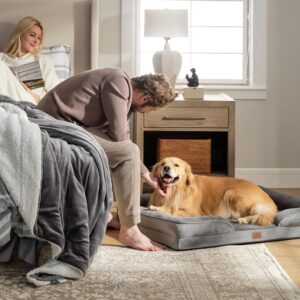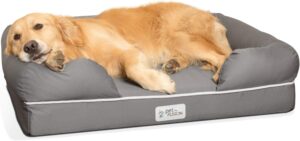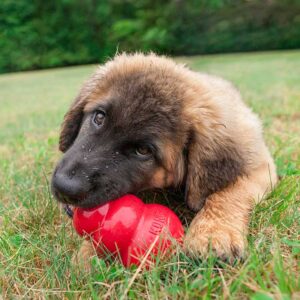 |
Key Points:
|
| Dogs have specific sleep needs based on their age, breed, and activity level. Puppies may require up to 20 hours of sleep, while adult dogs typically need 12-14 hours daily. Sleep consists of REM (dreaming) and non-REM stages, which are essential for physical recovery and mental restoration. Factors such as a dog’s age, breed, and activity level influence its sleep patterns.
To ensure quality sleep, maintain a consistent schedule, create a comfortable and quiet sleeping area, and provide mental stimulation during the day. Recognizing signs of sleep deprivation, such as irritability or reduced immunity, is key to adjusting your dog’s routine. Regular observation and a sleep-friendly environment can enhance your dog’s health and happiness. |
|
How Much Sleep Does a Dog Need?
The amount of sleep a dog requires can vary based on age, breed, and activity level. Generally:
- Puppies need up to 20 hours daily due to rapid growth and development.
- Adult dogs typically sleep between 12-14 hours per day.
- Senior dogs may need more rest as they age, often around 16-18 hours.
Understanding Your Dog’s Sleep Cycle
Dogs have sleep cycles similar to humans but much shorter. They go through both REM (Rapid Eye Movement) sleep and non-REM stages.
- REM Sleep: This is the deepest sleep phase, where dreaming occurs. Dogs may twitch or make noises, which is normal and part of their REM phase.
- Non-REM Sleep: In this stage, your dog’s body and mind recover. This phase helps in healing and physical restoration, making it essential for active or working dogs.
Factors Influencing Dog Sleep Patterns
Several factors affect a dog’s sleep needs and patterns, including:
- Breed: Working breeds, like Border Collies, need less sleep than breeds known for relaxation, such as Bulldogs or Great Danes.
- Age: Younger and older dogs require more sleep for growth and recovery.
- Activity Level: Active dogs with higher exercise needs may sleep more to restore energy levels.
Sleep Needs Based on Dog Age and Breed Type
| Dog Type | Age Group | Average Sleep Needed |
| Puppies | All breeds | 18-20 hours |
| Small Breeds | Adults | 12-14 hours |
| Large Breeds | Adults | 12-16 hours |
| Senior Dogs | All sizes | 16-18 hours |
Recognizing Sleep Deprivation in Dogs
Sleep deprivation can affect dogs similarly to humans, causing behavioral changes and health issues. Signs of sleep deprivation include:
- Irritability: Your dog may growl or snap more than usual.
- Decreased Immunity: Chronic sleep deprivation can lower immune function.
- Reduced Cognitive Function: Sleep-deprived dogs may appear confused or disoriented.
If you observe these signs, consider adjusting your dog’s routine to support more restful sleep.
Common Sleep Patterns in Dogs
Dogs often experience segmented sleep, meaning they may wake several times at night or nap intermittently during the day. These patterns can vary:
- Day Naps: Many dogs sleep in short cycles during the day, especially when they don’t have a full eight-hour block at night.
- Night Sleep: Dogs may mirror human sleep schedules but wake up more frequently to check their environment.
Typical Sleep Patterns for Different Activity Levels
| Activity Level | Common Sleep Pattern | Notes |
| High-energy | Short naps, longer night sleep | Often alert during the day |
| Moderate | Several naps, consistent night | Balanced energy requirements |
| Low-energy | Long naps, shorter night sleep | Older or relaxed breeds often |
Enhancing Your Dog’s Sleep Quality
Here are some practical steps to create a sleep-friendly environment:
- Establish a Routine: Try to keep feeding and exercise schedules consistent to align with your dog’s natural rhythms.
- Create a Cozy Space: Use comfortable bedding and a quiet, dim space to help your dog relax.
- Limit Distractions: Avoid disturbing your dog while they sleep, especially during deep sleep.
- Provide Mental Stimulation: Mental enrichment helps use energy constructively, allowing your dog to sleep more soundly.
What if Your Dog Sleeps Too Much?
It might be worth investigating if your dog seems to be sleeping excessively. Possible causes of excessive sleep include:
- Medical Conditions: Hypothyroidism, obesity, and certain medications can lead to excessive sleep.
- Boredom: A lack of mental or physical stimulation can cause your dog to nap more often.
If you’re concerned, consult your veterinarian for advice.
Excessive Sleep Warning Signs and Possible Causes
| Warning Sign | Possible Causes |
| Sudden increase in sleep | Thyroid issues, anemia, boredom |
| Difficulty waking up | Arthritis, pain, age |
| Low activity level | Obesity, lack of stimulation |
How to Monitor Your Dog’s Sleep Patterns
Monitoring your dog’s sleep can help you detect changes in their health. You can do this by:
- Observing Sleep Times: Track how long your dog spends sleeping each day.
- Recording Night Activity: Use a pet monitor if you’re curious about their night movements.
- Scheduling Routine Vet Visits: Regular check-ups can rule out sleep-related health issues.
Signs Your Dog Needs Sleep
| Sign of Sleepiness | Description |
| Excessive Yawning | Your dog frequently yawns, indicating drowsiness. |
| Droopy or Squinting Eyes | Eyes appear half-closed or squinting, showing fatigue. |
| Slower Movements | Your dog moves sluggishly, with reduced energy levels. |
| Decreased Interest in Play | Lack of enthusiasm for toys or activities they usually enjoy. |
| Seeking Quiet Spots | Your dog may seek out a quiet, isolated spot to rest. |
| Irritability | Unusual grumpiness or reluctance to engage with others. |
| Increased Napping | Your dog starts napping more frequently during the day. |
| Heavy or Sighing Breaths | Audible, deep breaths or sighs indicate relaxation and sleepiness. |
Recommended Bedtime for Your Dog
| Factor to Consider | Suggested Bedtime Range | Explanation |
| Puppies | 8:00 – 9:00 PM | Puppies need ample rest for growth, so an early bedtime helps establish a consistent sleep routine. |
| Adult Dogs | 9:00 – 10:00 PM | Adult dogs benefit from a bedtime that aligns with their owner’s schedule and daily activity level. |
| Senior Dogs | 8:00 – 9:00 PM | Older dogs may need an earlier bedtime as they tire more easily and need extra rest for recovery. |
| High-Energy Breeds | 9:00 – 10:00 PM | These breeds may require a later bedtime after extra evening exercise or playtime. |
| Low-Energy Breeds | 8:00 – 9:00 PM | Breeds with lower energy levels often prefer an earlier bedtime, matching their relaxed routine. |
10 Dog Sleeping Positions and Their Adorable Meanings
| Sleeping Position | Description | Meaning |
| Curled Up (The Fuzzy Bagel) | Dog curls into a ball, nose to tail | Shows a need for security and warmth; commonly seen in dogs resting outdoors or in winter. |
| Side Sleeper | Dog lies on its side, legs outstretched | Indicates comfort and relaxation; this position shows the dog feels safe and secure. |
| Superman (Belly Down) | Dog lays on stomach with legs out front | Often seen in puppies, meaning they are ready to jump back into action quickly. |
| Belly Up | Dog sleeps on back with paws in the air | Sign of extreme comfort and trust; they feel safe and are cooling off. |
| The Cuddle Bug | Dog sleeps snuggled up to another animal or person | Shows affection and a desire for closeness and bonding with pack members. |
| Lion’s Pose | Front paws out, head resting on paws | Indicates a light sleep state, often with alertness, ready to wake up if needed. |
Quick Tips on Do’s and Don’ts When a Dog is Sleeping
Do’s
- Do keep a consistent sleep schedule.
- Do provide a cozy bed.
- Do let your dog sleep undisturbed.
- Do observe for signs of restlessness.
- Do maintain a calm evening routine.
Don’ts
- Don’t startle your dog awake.
- Don’t allow excessive disturbances.
- Don’t force your dog to sleep in uncomfortable spaces.
- Don’t ignore excessive sleeping.
- Don’t disturb dreaming dogs.
Top 10 Amazon Picks for a Restful, Comfortable, and Stress-Free Sleep for Your Dog
Closing Thoughts
Quality sleep is essential for your dog’s health, impacting everything from energy levels and mood to immune function and overall well-being. By understanding your dog’s unique sleep needs and patterns, you can ensure they receive the restful, restorative sleep necessary to stay happy and active. Paying attention to factors like age, breed, and activity level can guide you in creating an environment that promotes better sleep quality, helping your dog wake up refreshed and ready for each new day.
As a pet owner, observing and supporting your dog’s sleep routine is a rewarding way to care for their health and happiness. From establishing routines to providing a cozy sleep space, your small adjustments can significantly impact their quality of life. When you recognize the importance of sleep in your dog’s daily routine, you contribute to their long-term health and nurture a stronger, more connected bond with your furry friend.











